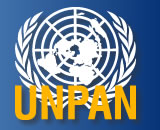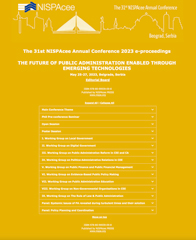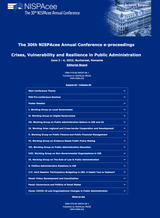| WG_News :: About WG :: Coordinators :: Activities :: WG_outputs |
Anti-corruption measures in policy making
Background
Corruption as a phenomenon that is part of the society since its inception is becoming part of research agenda in the past years. It is being analysed from the perspective of its causes, consequences, evolution and cultural, economic and social differences in the degree of its occurrence in various countries.
Transparency and accountability of public sector can be viewed as a public good – its consumption is non rival and non dividable. Several negative aspects of society are connected with non-transparency, particularly with corruption in public policy development stages, such as state capture[1].
Thus, anti-corruption measures that introduce transparency and accountability into the public administration sector is of outmost importance. For that purpose analysis of existing anti-corruption measures and tools (for example ethics, control, repression), analysis of best practices in individual areas[2] (e.g. in public procurement) that have been introduced in the context of a transition economy[3] in the last decade. From practical point of view, the existing experience with anti-corruption measures in individual CEE countries, the analysis of factors that enabled the introduction and implementation of these are the target of this working group.
Call for Papers
The focus of the papers presented in this working group is on the use of policy instruments (legal, economic, information and administrative) with anti-corruption strategies in a transformation economy. The main aim is the analysis of the factors that lead to successful implementation of anti-corruption measures: from their inceptions, struggle during the passing time to their maintance and sustainability in the practice. The papers will look at the institutional, economic and cultural and historic framework.
The ultimate aim of the research papers is to map anti-corruption measures from the perspective of policy instruments that have been introduced into the transition countries in the years 1995-2005. The focus is on all types of public administrating institutions, ranging from central institutions (ministries and specialized agencies) to self – governments on regional and local levels, judiciary, police and the like.
The papers should map the period of their inception by analyzing the policy entrepreneur behind the proposed anti-corruption measure instrument, his/her motivation, influence of supranational and international organizations and interest groups that created coalitions or fought against the measure and their possible motivations. The papers will look also at the measure and its reflection not only on political battle during the policy agenda, policy formulation and policy approval stages but also its reflection in media and public discussion. By analyzing the existing measures and its instruments we aim to have a discussion in the WG on questions, such as:
- What forms of policy instruments are best suited for transparency measures in relation to its goal it tries to achieve (public interest and other concrete goals: how public interest is defined),
- What influences and pressures are dominant in the policy making process during the anti-corruption strategies passing: local interests (e.g. in entering EU, attracting foreign investments, entering OECD, etc.) vs. foreign interests (influence of EC, World Bank, etc.),
- What interest groups are being formed and how do they try to influence the policy making process during anti-corruption measures adoption (ranging from business interests to non governmental organizations and their efforts to step into the process in line or against the proposed measure),
- What are the risks associated with putting forward the anti-corruption measure.
Any anti-corruption measure needs to have its contens (program), policy entrepreneur (leader who puts the measure on the agenda and pushes it through) and his/her coalitions for putting the measure forward and impulses for its realization (motivation). This can be assesed as the strategy for anti-corruption measures in public policy on central, regional or local levels and strategy of the government in creating coalitions with opposition, non governmental sector, businesses.
Research GuidelinesPapers should combine conceptual and empirical analysis. They should start with a clear statement of the conceptual framework, which they are using. The empirical analysis might be based on case studies, on primary data collection (e.g. questionnaire surveys, interviews), on secondary data (e.g. national or local statistics or performance indicators) or data from comparative studies. Where papers are based on case studies, the case studies should be selected on clear criteria, so that results are available for analysis and presentation.
We will give priority to papers in which the practical perspective is clearly represented. This might be, for example, through joint authorship, where authors represent academia and practical work, or through empirical research, which has explored and contrasted the views of stakeholders.
Papers should make clear:
· which public administration institution and area is the focus of the research (e.g. central government/particular ministry, local governments, judicial courts, police, agencies and/or business environment, education, housing, etc.);
· which policy instrument is the focus of the research: legal, economic, information or administrative (e.g. new administrative structure, access to information or balancing the information asymmetry, use of demand and supply rationale in combating corruption, lottery, legal instruments, etc.)[4];
· what anti-corruption measure the paper concentrates on (how the policy instrument chosen relates to the decrease of corruption and how it functions and works in practice);
· political economy of passing and maintaining the measure (political actors, leading personality or policy entrepreneur putting forward the measure, interest groups arguing for and against the measure, motivations, influence of external factors such as EU, World Bank, etc, changes made throughout the passage of the measure and its implementation and their impact on functioning of the measure, how the measure has been pictured and mirrored in media”;
· what empirical data collection and analysis has been employed;
· what results have emerged so far;
· how much confidence can be placed in these results in their own context;
· how far the authors believed the results might be generalized to other contexts.
In order to be eligible for publication, authors should pay careful attention to these guidelines.
The total length of the paper should not exceed 6000 words. If you have any queries, please check out your proposed approach with the chairpersons at an early stage.
Work Program
Selection of participants
All those interested in participating in the research activities of the Working Group were requested to submit a paper proposal by December 15, 2007 to the Working Group coordinators and the NISPAcee secretariat. The co-authorship between academics and policy advisors were strongly encouraged. The proposal should contain the following information:
-name/names of the authors,
-contact details (including email address),
-Institutional affiliation,
-Abstract of a proposed paper (max. 2-3 pages).
The Working Group coordinators will select papers and inform all participants by the mid January 2008 via the NISPAcee secretariat.
Selected participants will be asked to provide a detailed outline (5 pages) by January 31, 2008 and will submit completed papers by April 15, 2008.
Plenary meeting
The plenary meeting of the Working Group will take place during the NISPAcee annual conference in Bratislava. The working group will focus on presentation and group discussion of submitted papers. The best papers presented will be included in an edited volume.
[1] Hellman, Jones and Kaufmann (2000) define state capture where business firms are affecting formulation of policies and rules. Transition countries are particularly vulnerable to this practice as the transformation focused on the redefinition of the relationship of the state towards the private firms, but not vice versa (how firms influence public officials for their advantage).
[2] For example Integrity Pact – the concept, the model and the present applications, Status report, TI Berlín, 2000.
[3] See studies on this issue from different regions, such as Keefer, P. (1996). „protection against a Capricious State: French Investment and Spanich Railroads, 1845 –1875. „Journal of Economic History 56 (1):170-92, Khan, M. (1997). „Corruption in South Asia: Patterns of Development and Change“. Paper presented on 6. May , Brighton, University of Sussex. Scott, J.C. (1972) „Comparative Political Corruption“. Englewood Cliffs, N.J.: Prentice-Hall.
[4] see table of instruments at the end of this Call

This Working group is supported by Slovak Research and Development Agency.




 Price:
Price: 








